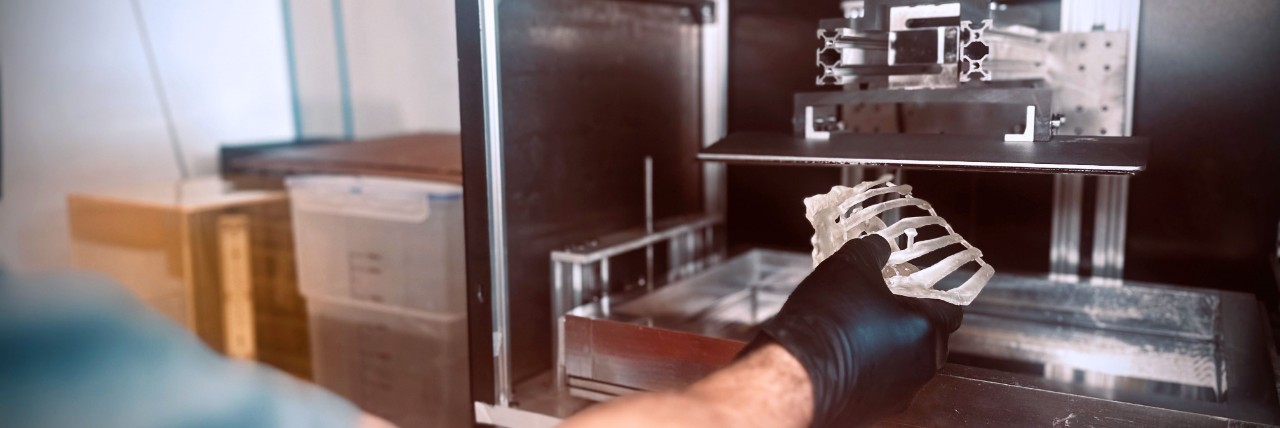
Doctors prepare for surgeries with 3D-printed organs
Venture Lab startup fast-tracks 3D-printed anatomical models
University of Cincinnati Venture Lab startup Meteora3D is at the forefront of providing ultra-fast, patient-specific 3D-printed anatomical models for surgeons worldwide, according to a recent interview on 55KRC. To date, the early-stage startup has raised over $500,000 for its technology development and validation.

Dr. Prashanth Ravi holds a 3D replica of a patient's heart in his hands. Photo/Meteora3D
Surgeons rely heavily on touch and spatial awareness to navigate complex procedures. Traditional 2D imaging methods such as CT scans, though, often fall short in conveying a comprehensive anatomical picture of patients.
Recognizing this limitation, Prashanth Ravi, PhD, CEO of Meteora3D and faculty in the UC College of Medicine’s Department of Radiology, partnered with Shane Cline, Meteora3D’s chief technology officer, to pioneer a technology that bridges the gap between digital imaging and hands-on surgical planning. They then brought on Kevin Ryan as business advisor to direct commercialization efforts and Jake Harrington as Meteora3D’s senior mechanical engineer for product development. The team is also in the process of bringing on board an internationally recognized medical advisor to further focus their efforts.
“For surgeons, understanding anatomy through two-dimensional images can be challenging,” Ravi says. “3D printing presents information in a way that aligns with how they think and work. That’s what drives us – to help them perform their jobs more efficiently.”
At the end of the day, that’s what drives us – knowing that our work will directly improve patient outcomes.
Prashanth Ravi, PhD, UC Department of Radiology CEO of Meteora3D
Inno under one roof

Meteora3D's innovative printing technology. Photo/Greg Glevicky
Meteora3D's journey began within UC’s 1819 Innovation Hub, where Ravi participated in the UC Venture Lab pre-accelerator program in 2022. Initial prototypes were developed using high-performance 3D printers and CNC machines on-site at the UC Ground Floor Makerspace inside the 1819 building.
The Venture Lab program and 1819 resources provided essential business guidance, helping transition the team’s research into a startup with a viable commercial product.
“Access to the Venture Lab’s incredible mentorship and early funding, and the makerspace’s state-of-the-art infrastructure, were instrumental in Meteora3D successfully executing early prototyping and customer discovery,” Ravi notes.
While medical 3D printing exists, current solutions can take days to produce a single model – an impractical delay for trauma and emergency cases. Meteora3D's innovative printing technology drastically accelerates this process, enabling the creation of same-day patient-specific organ models.
Holding an exact replica of a patient’s organ before surgery enables better planning, reduced operative times and improved patient outcomes.
From concept to commercialization

The Meteora3D team, from left to right – Jake Harrington and Shane Cline (background), Kevin Ryan (seated), and Prashanth Ravi stand alongside their 3D printing technology. Photo/Greg Glevicky
Meteora3D was officially incorporated in August 2023 and the company secured its first major grant through Ohio’s Entrepreneurial Services Provider program in May 2024, enabling continued prototype development. Working with the UC College of Medicine, the team is now clinically testing its technology to refine and expand its capabilities across multiple surgical specialties.
Game-changing potential
Meteora3D's technology has already demonstrated its potential in real-world applications. In one case, a 3D-printed abdominal vessel stent model helped an interventional radiologist determine the best stenting approach. This ability to physically assess patient anatomy before surgery is proving to be a game-changer across specialties.
Meteora3D’s efforts have also gained strong financial backing. To date, the startup has raised over $500,000, including $275,000 from the prestigious National Science Foundation SBIR Phase I grant and nearly $200,000 from UC’s Venture Lab. Additionally, the company has a pending patent through UC's Office of Technology Transfer and is currently testing its first beta prototype, with plans already in place for second and third iterations.
This month, Ravi has been chosen as a recipient of the Faculty Entrepreneurship Award for 2025 by UC President Neville Pinto.
Pushing the boundaries of medical innovation
With the rapid evolution of automation and speed in medical 3D printing, Meteora3D aims to make this technology more accessible to hospitals and patients. “At the end of the day, that’s what drives us – knowing that our work will directly improve patient outcomes,” Ravi says.
As they continue their journey, co-founders Ravi and Cline hope that Meteora3D inspires future innovators in the field of medical 3D printing. “Be patient, stay curious and enjoy the process,” Ravi advises. “Innovation takes time, but the impact it can have on lives makes every challenge worth it.”
Featured image at top: A 3D replica of a patient organ inside Meteor3D's technology. Photo/Greg Glevicky
Innovation Lives Here
The University of Cincinnati is leading public urban universities into a new era of innovation and impact. Our faculty, staff and students are saving lives, changing outcomes and bending the future in our city's direction. Next Lives Here.
Related Stories
Doctors prepare for surgeries with 3D-printed organs
April 11, 2025
Meteora3D, a Venture Lab-backed startup, helps surgeons better understand upcoming procedures by designing and developing quick-to-produce, 3D-printed anatomical models.
Nursing innovation comes to life at UC’s 1819 Innovation Hub
February 28, 2025
Chief nursing officers from across Greater Cincinnati gathered at UC’s 1819 Innovation Hub to celebrate the profession’s many contributions and to highlight the potential for cutting-edge healthcare advances.
UC-backed startups receive funding from $1.4 million state grant
February 11, 2025
Two startups based on UC technology and supported by the UC Tech Transfer team and the 1819 Venture Lab were awarded $200,000 each from Ohio’s Technology Validation and Startup Fund.
